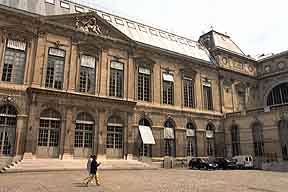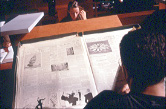Alert watches over our heritage in the French National Library
Coupled with CEDELECs Vespa supervisor, ALERT ensures the preservation of the most ancient archive documents, objects and costumes in Frances heritage.
History
The Richelieu site was the historical birthplace of the French National Library (BNF), which was founded in 1720. The site has been gradually shaped and modified over the centuries, with the first buildings dating back to the time of Mazarin.
This site harbours four of the BNFs oldest collection departments, these being:
- maps and plans
- prints and photographs
- manuscripts, western section and oriental section
- Coins, medals and antiques
- Music
- Performing arts
Description of the monitoring system
The monitoring system comprises three operations stations equipped with CEGELEC’s VESPA supervisor. One of these stations runs the Alert application. The system includes an Ethernet network and three field networks, which handle 25 local processing units for a 300-input/output database. The information from the local processing units is sent to the monitoring system via CEGELEC ASPA VE 7000 cards.
In total, over 100 critical or high-priority alarms are monitored. These are sent via mini-SMS message to the mobile phones of the different managers concerned by the alarm. The BNF’s maintenance staff are permanently based at the sight. When a critical alarm is detected, SAMEX’s specialist maintenance staff address the problem on-site. Alarms can also be sent by fax to the “Central Fan Coil” department, to the offices of SAMEX and to the security PC.
Main types of alarm
Numerous criteria must be taken into consideration to ensure that archive documents and other precious objects stored at the Richelieu site remain perfectly preserved.
The air treatment plant is permanently monitored to ensure that the quality, humidity and temperature of the air in the manuscript storage areas remain constant and fulfil precise preservation conditions, in particular in the case of archives that are classed as “fragile”. Fluid levels are also checked continuously, thus ensuring that the heating and air-conditioning system remains constantly operational.
The library’s power plants are also monitored and the consumption of its different sources of electrical energy is checked systematically. When the maximum consumption level is reached, certain energy sources are shed in order to maintain electrical consumption below a pre-defined threshold. Similarly, in the event of a power cut, a backup generator takes over so that power can be restored to critical buildings.
The Richelieu site in brief:
- 65,000 m2
- 20 million documents
- 8 reading rooms
- three exhibition galleries
- a catering department and four dining areas
- a reprographics department
- 450 employees and a fire-fighting detachment

The system also monitors sump levels and checks that waste removal pumps are functioning correctly, in order to notify maintenance staff if there is a risk of flooding or overflowing.
Summary
To sum up, our heritage is preserved in an optimal manner, because the primary factors of influence in the preservation of ancient relics, in particular the library’s manuscripts, are checked on a permanent basis.
|